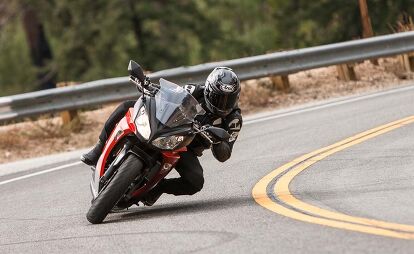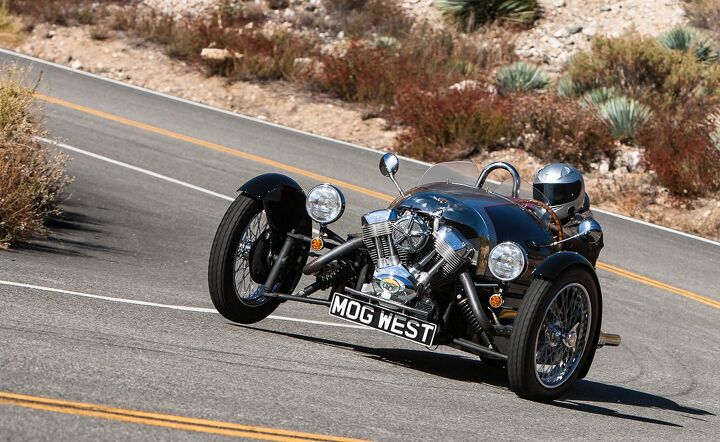Trizzle's Take – Finding Limits

Exploring the limits of traction on two - and three - wheels
Having the chance to partake in our recent 3 Wheeler shootout, I was fortunate enough to pilot three very different machines. Two of which, let’s face it, are basically cars with one rear wheel. Apart from the obvious fun we were having romping on the different “motorcycles,” what I distinctly remember was the ease at which I was willing to explore the limits of the Morgan 3 Wheeler and the Polaris Slingshot, the former void of any electronic aids, the latter with switchable stability control (the Spyder F3 stability system is always on).
Entering a corner on either the Morgan or Slingshot, I wasn’t afraid to approach it slightly hot. I felt I could experiment with weight transfer and the resulting effects it would have with regards to understeer or oversteer without major consequences. If I were to do that on two wheels, chances are I would end up on my head. Being able to slightly exceed my limits is what makes cars (or trikes, as the case would be) fun in my opinion. However, I enjoy the challenge of exploring, but never exceeding, my limits on two wheels.
A friend of mine races cars and does the occasional motorcycle trackday from time to time. We were chatting one day when he says to me, “The thing about car racers is that we break the limits all the time and then back off from there. Motorcycle racers though, they know how to push right up to the edge, but not go past it.”
It’s something I’ve thought about ever since. Maybe it’s coincidental, but before I heard these words there was a point a few years back where I was crashing. A lot. I didn’t respect the limits, but also, I didn’t know exactly where the limits were. Crashing helped me find them. Of course, that method wasn’t easy on the body, the wallet or my employment status. Nor was it favorable in the eyes of OEMs who were lending me their bike.
Maybe that’s what makes the child prodigies I see at the track so amazing to watch. They haven’t experienced real pain or fear from a big crash, so it’s natural for them to lean further and further, or charge a corner faster and faster. They also don’t have to pay to fix their own bikes, either. That first big crash is a good test to see how committed some are to the sport.
So, am I saying we should all crash to find our limits? Of course not. It’s also completely fine if a child (or adult) decides to hang up their helmets after getting their bell rung. Motorcycling isn’t for everyone. For the rest that remain, how do you find your limit without falling down?
While a riding and/or racing school is a great option, not everyone can afford one. Riding in the dirt is great training, too, but not everyone is interested in that. Allow me to share a bit of advice I was told by former World Superbike champion, Doug Polen. It’s simple: “Listen to your tires,” he said. The only contact between your motorcycle and the ground, tires speak volumes. It’s up to us to listen.
Obviously, traction is decreased when the road is wet. Take it easy. But tires tell other signs, too. I’ve had cold rear tires spin slightly when given too much throttle, and front tires push when ridden to the point of their performance limits. Another time, I couldn’t pinpoint why I was riding much more timidly than usual, other than to say something just didn’t feel right. One key to reading the signs before it’s too late is being smooth with inputs. Not being ham fisted with the throttle helped save the rear end slide; progressively applying brake pressure allowed the front to gently push, whereas grabbing a handful of brake would have overwhelmed the front and caused a crash.
Overall, however, trust your instincts. That’s what saved me in the last scenario. Whether the bike isn’t feeling right, the conditions aren’t ideal, or your mind is somewhere else, sometimes we ride sensing something is just “off.” Those aren’t the times to explore the limits. Play it cool and get home in one piece. But for those times when everything feels right, when man and machine are in perfect harmony, skirting the edge of our personal limits is an exhilarating feeling that simply can’t be matched on four – or three – wheels.

Troy's been riding motorcycles and writing about them since 2006, getting his start at Rider Magazine. From there, he moved to Sport Rider Magazine before finally landing at Motorcycle.com in 2011. A lifelong gearhead who didn't fully immerse himself in motorcycles until his teenage years, Troy's interests have always been in technology, performance, and going fast. Naturally, racing was the perfect avenue to combine all three. Troy has been racing nearly as long as he's been riding and has competed at the AMA national level. He's also won multiple club races throughout the country, culminating in a Utah Sport Bike Association championship in 2011. He has been invited as a guest instructor for the Yamaha Champions Riding School, and when he's not out riding, he's either wrenching on bikes or watching MotoGP.
More by Troy Siahaan


































Comments
Join the conversation
My first, and only, crash was on a small 125cc scooter while playing Ricky Racer in the back alleys of Saigon a few years back. I had on gloves, jeans, jacket, full-face helpmet, and Doc Martens, so there was no injury when I low-sided (other than to my ego), but thinking about how lucky I was not to have to spend time in a foreign hospital definitely make me, err, "reevaluate" my riding proclivities.
So, my take-away is that if you're going to dumb things on two-wheels, do it slowly and on a scooter. With barely any power comes much less responsibility!
In the last five years I've ridden 100,000kms on a honda 919, and I've never come off it. I go on long trips, rides through the mountains and commute in Sydney traffic. I don't do track days. I consider myself a risk aware rider, but I often find myself passing other bikes. Let's say I ride at an average pace on a fastish bike. It probably helps that I spent my teenage years riding dirt bikes and my 20s riding a push bike in traffic (never fell off then either). By the time I got the hornet I was used to being invisible on the road and taking responsibility for avoiding collisions, even when someone else is at fault. Well. So far so good. I guess what I'm saying is you can ride without crashing. The only time you need to do really push the limits would be in a race, which I don't do because I value my life and bike.